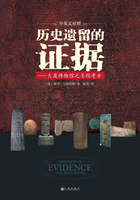
Introduction

The Route Is Important
The British Museum holds a huge number of major discoveries that provide direct corroboration and background confirmation for an immense sweep of Bible history. This survey of Bible-authenticating exhibits has been designed as a guide for visitors, and also to give pleasure and interest to readers unable to tour the galleries. In a couple of hours or more it is possible to tour a selection of exhibits which constitute an outstanding summary of the whole field of archaeological discovery relating to the Bible. In today's atheistic climate most people have no idea how much powerful evidence exists for the literal accuracy of the biblical record.
Yet there are many benefits to be derived from reviewing archaeological discoveries that confirm the historical accuracy of the Bible, because these discoveries reassure seekers, illuminate events and decisively refute the claims of cynics.
The route followed in this book has been used (and updated) for very large groups of adults, students, seminarians, and other young people, for more than forty years.
Some biblical evidence tours take a different route in an effort to follow the order of Bible history, beginning in the upstairs galleries with Abraham’s boyhood city of Ur, and going on to Egyptian exhibits, and so on. The problem with this route is that the visitor sees much less direct authentication of Bible events for the first half of the tour. Only in the second half, when pretty tired, does the visitor make it to the most stunning exhibits of all. (Furthermore, the chronological aim is soon frustrated by the layout of the galleries and cannot be maintained.)
We therefore begin in Assyria with some of the most powerful direct ‘proofs’of biblical people and events. This is the best order for people taking an enquiring interest in the authenticity of the Bible, as well as for students, whom any museum still evokes ‘school-trip’ syndrome. Subsequently, visitors are able to appreciate all other exhibits in a more focused way.
Because we begin with the ninth century BC – the interaction between Assyria and Israel –time charts are provided throughout the book to maintain perspective.
Rooms Sequence
The route followed in this book takes a sequence as follows (some rooms will be visited twice).
Room 6 Assyrian Sculpture
Room 7 Nimrud Palace Reliefs
Room 8 Nimrud Palace Reliefs
Room 10 Khorsabad Palace Reliefs and Assyrian Sculpture
Room 88 Archaeology of the New Testament
Room 89 Assyrian Art
Room 9 Nineveh Palace Reliefs
Room 4 Egyptian Sculpture
Room 57 The Ancient Levant
Room 56 Early Mesopotamia
Room 55 Later Mesopotamia

Sir Austen Henry Layard, British diplomat, catapulted to fame as an archaeologist by his momentous excavations of Assyrian palaces 160 years ago, was no mean artist. This is his watercolour entitled ‘Excavations at Nineveh’.
Room 53 Ancient Anatolia
Room 52 Ancient Iran
Room 65 Egypt and Africa
Room 63 Egyptian Funerary Archaeology
Room 61 Understanding Ancient Egyptian Culture
Room 70 Rome: City and Empire
Room 69 Life in Ancient Greece and Rome
Room 68 The Money Gallery
Room 49 Roman Britain
Room 4 Egyptian Sculpture
Room 18 The Parthenon